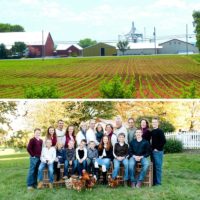Alderfer Eggs

| Rating |   |
| Farm/Brand Headquarters | Telford, PA |
| Website | https://alderfereggs.com/ |
| Market Area | Central, Southeast |
| Total Score | 435 |
This brand may supply some of Kirkland Signature Organic Brown Eggs.
| Criteria | Points | Comment |
|---|---|---|
| TOTAL (possible score is 1700) | 435 | 2-egg   |
|
Brands that have close daily control over their egg production receive the most points. Ownership Structure | 70 | Family business with home farm and contract farmers |
|
Brands that only produce organic products make the biggest investments — in time and money — in systems that benefit us all. Eggs sourced from a single operation receive the most points. Eggs of unclear origins and/or with poor oversight receives the fewest points. Commitment to Organic Label | 25 | Produces both conventional and organic eggs, unknown if production is split on same properties |
|
Additional certifications, depending on the credibility of the label, can demonstrate a commitment beyond the organic standards. Other Labels and Standards | 30 | Certified Humane (cage free) is the only label this brand may be using; likely only meeting "cage free" requirements |
|
Smaller flock sizes (the number of laying hens per housing structure) offer better animal welfare conditions. Flock Size(s) | 20 | Size varies widely by supplier, up to around 25k |
|
The best housing offers space for natural behaviors and legitimate access to the outdoors through adequate exits. Hen Housing and Exit Areas | 25 | Fixed housing, likely uses aviary housing, outdoor access is non-rotated, only some houses have access to pasture and not all hens can access outdoors easily |
|
Adequate indoor spacing reduces stress and disease. With less crowding, birds can stretch their wings and more easily perform other natural behaviors. Indoor Spacing | 20 | Possibly 1.2 square feet per bird, not confirmed |
|
High scoring brands provide enough space to allow each hen to fully utilize their outdoor area, and to perform instinctive behaviors without harming the environment. Outdoor Spacing | 0 | Likely 0.2 to 1.2 square feet/bird, where outdoor access is required |
|
High quality outdoor access includes vegetation, soil, and ample opportunities to forage year-round. Quality of Outdoor Access | 0 | Not confirmed; outdoor access is provided but it is poorly utilized by the birds |
|
Birds that are introduced to the outdoors early are more accustomed to spending time outdoors without fear or stress. Outdoor Access Timing | 0 | Unknown |
|
Year-round access to perches, scratching areas, deep litter, novel foodstuffs, and dust bathing contribute to quality of life. Enrichments | 20 | Unknown enrichments indoors and poor outdoor access enrichments |
|
Chickens use their beaks to interact with the world. Authentic organic farmers account for this behavior, eschewing beak trimming. Alterations | 0 | Unknown, alterations are likely; forced molting |
|
Raising chicks on farm or buying them from certified organic hatcheries shows dedication to organic production from start to finish. Chicks and Pullets | 50 | Brand purchases chicks to raise into pullets |
|
Brands that have low rates of deaths and utilize their spent hens for human consumption or similar score the highest. Deaths, Culls, and Spent Hens | 25 | Likely over 5%, hens sold live or |
|
Brands that closely monitor and manage health of soil, native species, and water quality receive the most points. Environmental Impacts | 25 | Unknown policies, manure used on farm or sold |
| Feed Sourcing | 0 | Unknown feed sourcing |
|
Brands that score well here go above and beyond to ensure the highest animal welfare, taking into consideration their hens’ safety and cleanliness, natural behavior, and stress levels. Animal Welfare | 75 | Good animal welfare benchmark |
|
Cornucopia believes you have a right to transparency. Top brands share information with Cornucopia via a survey and cooperate with our own independent investigations. Transparency | 50 | Did not participate in recent survey, but some information could be confirmed by previous survey and investigation |
| Soy free and/or gluten free? (non-scoring) | Unknown, check packaging | |
|
Brands do not receive points, but are invited to submit the name of their Accredited Organic Certifier (suppliers may have different certifiers). Organic Certifier (non-scoring) | PCO | |
|
Extra credit is offered for various practices that go above-and-beyond in some form. Extra Credit | 0 | None |

